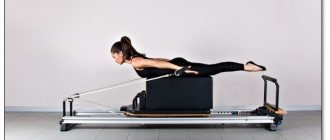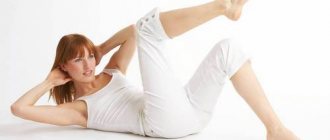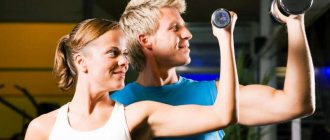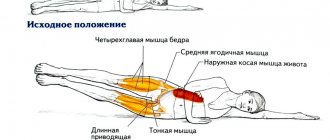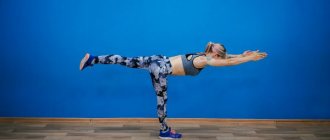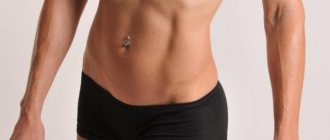SET OF EXERCISES TO DEVELOP FLEXIBILITY fig. 10.3
1. I. p. - sitting on the floor, raising straight arms up, palms forward. Pull your arms back with the help of a partner 5-10 times in a row.
2. I. p. - standing with your back to the gymnastic wall at a distance of a step from it, legs apart. Intercepting the slats with your hands from top to bottom, make a bridge. Repeat 3-5 times in a row.
3. I. p. - standing facing the gymnastic wall at a distance of two steps from it, legs apart, holding the bar in front of you with your hands (do not bend your arms). Perform springy forward bends until failure. Repeat 5-10 times in a row.
4. I. p. - standing with your feet apart, holding a gymnastic stick behind your back in the bend of your elbow joints. Perform springy bends forward, trying to touch your knees with your face (do not bend your legs at the knees). Repeat 5-10 times in a row.
5. I. p. - standing with your back close to the gymnastics wall, legs apart, holding the bar at shoulder level with your arms bent at the elbows. Bring your pelvis forward and straighten your arms to bend over. Repeat 5 times in a row.
6. I. p. - lying on your chest, legs together. Raise your arms back and, with the help of a partner, bend your torso. Repeat 5 times in a row.
7. I. p. - standing, toes on a slight elevation, hands on the belt. Rise onto your toes and lower yourself. Repeat up to 10 times in a row.
8. I. p. - standing in a forward bend, legs apart, toes to the sides, palms resting on the knees. Sit down slightly and perform circular movements with your knees inward and outward using your hands. Repeat up to 10 times in a row.
9. Same as the previous exercise, but legs together.
10. I. p. - standing with your legs apart, holding a gymnastic stick with an overhand grip on the ends (the narrower the grip, the more difficult it is to perform the exercise). Without bending your arms at the elbow joints, twist, lowering the stick behind your back, return to i. p. Repeat 3-5 times in a row.
11. I. p. – standing bending forward, legs apart, hands joined behind your back. With the help of a partner standing opposite, bend down while moving your arms back and up. Repeat 5-10 times in a row.
12. I. p. - standing in a forward bend, legs together, joining hands behind the head and spreading elbows to the sides. Bend your knees and rotate your torso to the right and left. Repeat 5-6 times in a row in both directions.
13. I. p. – standing legs apart, barbell in lowered hands. Bend your torso until the barbell touches the platform (do not bend your knees), return to i. p. Repeat 5-6 times in a row.
14. I. p. – standing legs apart. Arching your back, make a bridge with or without the help of a partner. Repeat 3 times in a row.
15. I. p. - lying on your back, legs together, arms to the sides and down. Raise your legs straight and touch your toes behind your head, return to i. p. Repeat 3-5 times in a row.
The level of development of flexibility must be constantly monitored. To do this, mobility in a particular joint is periodically measured (in degrees or linear dimensions) (Fig. 10.4). To obtain an indicator specific to weightlifting sports, it is necessary to use control exercises that are close in structure to the technique of classical exercises (or its parts), which involve the most significant muscle-joint groups for the athlete (see Fig. 10.3).
Pain while stretching
Painful sensations during stretching are completely normal. All athletes who stretch experience pain of varying intensity. The main thing is not to be afraid of these sensations, not to confuse them with sharp traumatic ones, and to react correctly.
So, pain can be different: tolerable, unbearable and burning. Tolerant will accompany you in every stretching exercise. Get used to it. Mentally say that you are not in pain, while breathing deeply. Turn on some nice relaxing music and focus on it. This way you will gradually get rid of the fear of stretching and reduce pain.
You can achieve unbearable pain on purpose. This will strengthen the stretch and speed up progress. At the end of the approach, bring the muscles to a state of unbearable pain, hold for a few seconds, and then smoothly exit the pose. You should not endure increased pain for a long time.
If you feel a tingling sensation when stretching, lighten the pressure slightly. If a burning sensation occurs, you need to very smoothly exit the position. When you come out of the position, relax and let your muscles recover. You can't tolerate the burning sensation for long.
Hand rotation and twisting
The next exercise to develop flexibility almost completely repeats the previous one. You need to stay in the same stance with your arms in the same place, but if last time you rotated your hand, now you need to rotate your whole arm. The score remains the same. Do, for example, four forward rotations and then switch to a backward rotation. This is where the warm-up exercises end, and you are faced with more serious tasks. In the next exercise you will need your first one. It is best if it is a special gymnastic stick, but any oblong object or even a rolled up towel will do
It is important that you can grasp it with your arms wider than shoulder-width apart. Perform straight arm raises, after which you need to twist back without releasing your apparatus
Repeat this exercise, each time making the task more difficult for yourself - reducing the distance between your hands on the apparatus. This is where a set of exercises for developing flexibility begins - more complex tasks await you.
Training Tips
To get maximum results from flexibility training or at home, use the following tips:
- Do everything slowly: be patient, do special exercises slowly to avoid injury.
- Repetition is the mother of learning : flexibility comes and goes, so do aerobic and dynamic exercises consistently, even if you have achieved what you wanted.
- Appreciate the little things : Sometimes stretching can actually be harder than strength training because it can be difficult to achieve visible results.
- Focus on exercise : Just like yoga, try to forget about the rest of the day and any problems in your life. Relieving tension will increase the effectiveness of exercise.
- Close your eyes : Once you feel that you are safe in a particular position, close your eyes. Thus, the emphasis is on one of the feelings or sensations. This is an easy path to self-discovery.
Exercises for a flexible body
- The benefits of flexibility
- 10 exercises
- Adviсe
The benefits of flexibility
A slender and beautiful figure, a beautiful gait - these are not all the benefits of stretching.
The plasticity of muscles and joints serves as an excellent prevention of many diseases, as well as:
- Reduces the likelihood of injury;
- Muscles and joints respond well to new physical activity;
- Develops coordination and endurance;
- Improves blood supply to the body as a whole;
- Correct posture is formed.
10 exercises
It is advisable to start developing flexibility from early childhood. But even in adulthood, sports activities for flexibility will be very useful. They can be performed independently, or they can be combined with other types.
Please note: before starting classes, be sure to consult your doctor about contraindications. We have selected for you the 10 most effective stretching exercises that anyone can do, regardless of physical fitness.
- Raise your straight arms above your head, clasp your hands and stretch your arms up, then in the same position, move your arms back a little and stretch again.
- Standing against a wall, lean your right arm bent at the elbow against the wall. Bend your left leg at the knee and, supporting your calf or ankle with your left hand, pull your leg towards the pelvis. Switch arms and legs.
- From a standing position, bend forward, alternately trying to reach your left and right feet with your hands. Don't bend your knees.
- Place your feet shoulder-width apart and raise your arms straight above your head. Make slow tilts to the left and right. Don't bend forward, keep your back straight.
- Sitting on the floor, spread your legs shoulder-width apart and alternately reach with your hands to the toes of your left and right feet. Try to keep your legs and back straight.
- Sit on the floor, stretch your legs forward and rest your back on your straight arms. First, pull your socks forward, then pull them towards you. After this, perform circular rotations of the ankle in turn: outward, then inward.
- Standing against a wall, lean your hands on it and lift yourself onto one toe, then the other, and then both.
- From a standing position, rest your hands on the back of a chair or table. Alternately move your right and then your left leg back, then to the side.
- Get on all fours, stretch your right arm forward, left leg back, look at the floor. Try to keep your outstretched arm and leg in a straight line. Repeat on the other arm and leg.
- Lie on your stomach, lean on your straight arms placed next to your stomach or slightly in front. Slightly tilt your head back and stretch the top of your head towards your feet. To make it more difficult, you can bend your knees and stretch them towards the top of your head. You will get a “ring”.
Adviсe
To ensure that your workouts bring the desired results and that the workout itself brings you joy, follow these simple tips.
- Before starting your workout, be sure to warm up;
- All stretch exercises should be done slowly;
- Watch your breath, don’t hold it;
- Start with simple exercises, gradually making them more difficult;
- Exercise regularly;
- Play your favorite music in the background.
10, 30 or 50 years old - any age is not an obstacle to playing sports! And if you don’t naturally have good body flexibility, our tips and simple flexibility exercises will help you achieve amazing results! Published by econet.ru.
PS And remember, just by changing your consciousness, we are changing the world together! econet
Is it worth going to special training?
First of all, a good fitness class should be lively, with an individual approach to everyone, where an attentive instructor will correct, give advice and offer exercise options that are difficult to do at home. If you have some free time, the gym is nearby and your funds allow, then it’s worth signing up for such classes.
We recommend: gym training program for beginners.
Some private classes include elements of “assisted stretching,” when the instructor helps you and guides you during training, because it is not always possible to squat to the desired depth from scratch on your own, reach any part of your body, or stretch. Group fitness classes are also about meeting people with similar interests face to face. No online group can replace the element of social interaction.
Stretching exercises vary in range of motion, some of which may include elements of yoga or Pilates. The classes are designed and useful for men and women with any experience and level of physical fitness, so don’t worry too much that you will be a “black sheep” there.
Flexibility
Flexibility is the ability of the body's muscles to relax and be easily stretched. Exercises to develop flexibility are essentially stretching exercises. Their main task is to increase the range of motion of the joint and lengthen pathologically shortened muscles.
People naturally have varying degrees of flexibility. This is due to the individual anatomical features of the body structure. With age, the range of motion steadily decreases. And simple actions, which you simply did not pay attention to in your youth, are difficult, and sometimes just require titanic efforts. You can avoid this by regularly performing a set of stretching exercises.
Flexibility exercises are available at any age.
What sports require flexibility?
Flexibility, as an indicator that facilitates the performance of movements with maximum amplitude, is clearly expressed among gymnasts, whether rhythmic or artistic gymnastics. All exercises demonstrate strong deflections and high swings, jumps, which are achieved by stretching the muscles and eversion of the joints. And also in figure skating, dancing, and martial arts, a high level of flexibility is needed.
And for those who engage in certain types of fitness, such as yoga, Pilates, stretching, flexibility is also important, which, by the way, these same areas develop.
Improving body flexibility with ten stretching exercises
Flexibility is one of the properties that characterizes a healthy body. It tends to decrease significantly with age. Moreover, by age we do not mean the ephemeral 60 years; the process of loss of elasticity in ligaments and muscles begins with puberty. Thus, it is only natural that stretching is an integral part of physical training.
Thanks to stretching, muscles and ligaments gain elasticity, become dense and strong. Effective stretching is ensured by a set of simple exercises. The effect of which depends on the regularity of execution.
Before stretching exercises, you need to warm up the body for 10-20 minutes (depending on how long you have been involved in sports: less for veterans, longer for beginners). Stretching requires patience, do not immediately go for records, listen to your body.
There is no need to strive for maximum amplitude during the first lesson, and if pain occurs, the exercise should be interrupted.
If you have serious training experience and the risk of missing an injury is minimal, you can use weights, which will undoubtedly make the exercises more interesting.
Practice shows that regular stretching exercises reduce back and lower back pain.
So, first: stretching the lower back. The classic exercise is bending to the side: the back is straight, the stomach is tucked, one hand is on the belt, the other is extended upward.
Attention!
The tilt is performed in the direction opposite to the raised arm, with a gradual increase in amplitude. The body returns to a strictly vertical position.
The exercise is repeated 10 times in one direction and the same number in the other. Do this three times.
Second: stretching the back and lower back. A more complex option. The starting position is similar to the previous one, only the tilt is towards the raised arm. Stretch your arm every time you bend over. Do the same three times, 10 for each side.
Third: stretching your back and arms. Feet together, arms outstretched on the chair (be careful, the chair can jump out and, after making intricate turns in the air, land on your head). While in this position, alternately bend and arch your back, as low or high as possible, respectively. Three times 15 times.
Fourth: stretch the front of the thigh. Stand straight, take your foot by the ankle and move your knee as far back as possible. Lock the position
Please note: your back should be straight. Can be supported by the back of a chair
One set of 9 times for each leg.
Fifth: seated comprehensive stretching. Sitting on the floor, spread your legs as wide as possible, with your toes pointing towards the ceiling. Alternating bends: to the left leg, to the center, to the right leg - one approach.
You need to make 12 of them. And then another 24
Important - keep your back straight, do not round, and do not bend your leg at the knee. It is better to reduce the amplitude, but perform the exercise correctly
Over time you will be able to do it better.
Sixth: for veterans. The same bends to the leg, but one leg is bent at the knee and laid back, behind the body. Three repetitions 9 times for each leg. Not recommended for beginners.
Seventh: leg stretching. Starting position: foot on a chair. Straight leg. The back is straight, the abs are tightened. Two options: 1. Straight tilts to the toe; 2. Bend the raised leg to the side. At the same time, one hand is on the belt. Additional load on the lower back and back. Both exercises are performed in three sets of 8 times each, for each leg.
Eighth: straight bends to the floor. The lower back, back and legs are involved. The tilt is carried out calmly, without jerking. After each, return completely to a vertical position. Three sets of 6 inclinations.
Ninth: arm stretching. We put our hands behind our backs and lock them together. Raise them as high as possible and make several springy movements (without strong jerks). Three sets of 6 times.
Tenth: lastly. Lie down on the floor. Exactly, arms extended along the body. Gradually raise your legs and, above your head, touch your toes to the floor. To begin with, not a floor, but a taller object such as a chair will do. Fix in this position and count to 5. Slowly return to the starting position. Do 6 times.
By performing this set of exercises regularly (optimally every day, but every other day is possible) you will achieve excellent body flexibility, reduce back pain and significantly reduce the risk of injuries during strength training.
Effect on fat burning and weight loss processes
Stretching exercises alone won't shed those extra pounds, but good flexibility is the path to a healthier lifestyle, and the added ease of movement can be an incentive to exercise more and trim your belly and sides. Such exercises help a person better understand their body, feel and look better, increase self-esteem, and this motivates them to continue to exercise and eat right.
How to do the splits and achieve maximum flexibility in your body
Firstly, before you start stretching, you need to perform various jumps and leg swings, which will improve blood circulation and increase oxygen saturation of the muscles.
Secondly, it should be slow and smooth. Each element should last an average of 60 seconds. Depending on the degree of flexibility, this time can be reduced or increased. Meanwhile, all muscles should be relaxed. The back is always straight.
You will feel a little uncomfortable while stretching. But under no circumstances should this be painful. Pain is a sign that you have gone too far. And if you're going to continue like this, it could lead to injury.
Stretching: features and benefits
Stretching and flexibility exercises are useful for absolutely everyone: both ladies who want to become more flexible and graceful, as well as male athletes and just people who want to improve their health and learn to better control their body. To ensure that the exercises bring maximum benefit and effectiveness, pay attention to the following nuances:
- Stretching is divided into two types: static and dynamic . The essence of the first is that you will need to stay in a specific one position in order to create maximum load on the target muscle groups. Dynamic stretching involves making sudden movements. Dynamic loads are not recommended for beginners, since if the body is unprepared, it can provoke sprains and ruptures of ligaments and tendons.
- Stretching gives quick results . Once you start exercising, you will soon feel how your muscle strength has increased and your well-being has improved, as the body is actively saturated with oxygen. The figure will become more slender and graceful. And even your skin will become fresher. But, of course, do not expect that the second time you practice, you will be able to do the splits. You will obviously become more flexible after about three months of training.
- You cannot stretch from a resting state. Flexibility exercises are performed after active warming up of the muscles. You can jump rope, do squats, and do leg swings. And only when you feel that you are warmed up enough, start stretching.
- Stretching exercises can be performed at any time of the day. However, experts believe that the best time for this is evening. Smooth and simple gymnastics will help you calm down and relax after a hard day.
During the exercise, you should only feel tension in the muscles and ligaments, but in no case pain. A sharp, severe pain indicates that something is damaged in the body. Do everything carefully and smoothly, listen to your body and give it time to get used to the stress. If you hear crunching or clicking sounds, feel muscle spasms, dizziness or severe pain, stop exercising.
Why do beginners need stretching?
Untrained people gradually lose the flexibility of their movements, they are overcome by pain in the joints, arthrosis and osteochondrosis. Incorrect postures become so comfortable that a person can no longer sit or walk with a straight back. Easy stretching for beginners for all muscle groups, which can be performed even at home, will help to avoid pain syndromes, increase joint flexibility and reduce the risk of salt deposits.
In addition, constant viewing of mobile gadgets puts incredible strain on the neck and leads to changes in the cervical spine. Due to prolonged daily work at the computer, the chest is compressed, a burning sensation appears in the shoulder blades, and sometimes it even becomes difficult to breathe. A person assumes that he has problems with the lungs or heart, while daily warm-up, yoga or stretching of atrophied pectoral muscles and shoulders can eliminate pain, oxygen starvation and fatigue.
In the end, an inflexible body looks awkward and people in sedentary professions have a hard time in old age. Belated stretching of the back and shoulder girdle after many years of inactivity will not cure. Isn't it better to start regularly performing a set of simple exercises to prevent diseases of the musculoskeletal system?!
Arm muscle stretching
By performing stretches for the biceps and triceps, you are doing preventive maintenance for the elbow joints, traction tendons and wrist joints.
Triceps stretch
Raising your arm up, bend it behind your head and grab her elbow with your other hand. Smoothly pull your working hand downwards. A similar exercise is for the other hand.
Biceps stretch
Grab the door jamb. In this case, the thumb of your hand should “look” down, and your hand should be parallel to the floor. Then turn around so that your gaze is in the opposite direction from the “working” hand. Standing in this position, rotate the shoulder section of your arm upward until you feel a stretch in your biceps. Repeat a similar exercise for the other hand.
Breast stretch
Standing at the door frame, rest your hands on it so that the shoulder sections of your arms are parallel to the floor. Press into the doorframe, stretching your pectoral muscles as much as possible.

